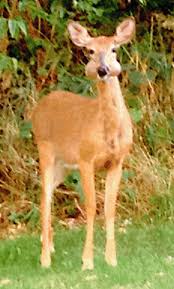Deer Repellents
Other Types of Deer Repellents
Wireless Deer Fence® Deer Repellents
Hundreds of commercial deer repellents of every type are available, indicating how serious the deer problem is in the U.S. and many other countries. In addition to commercial repellents, there are almost as many homemade deer repellents as there are frustrated gardeners.
Types of deer repellents
- Odor deer repellents make the entire area smell bad
- Taste deer repellents make the plants unappealing to eat,
- Mechanical deer repellents scare the deer
- Electrical deer repellents shock the deer.
Odor-Based Area Deer Repellents can be either biological or chemical. This type of deer repellent keeps deer out by filling the entire area with a strong odor.
A few odor deer repellents don’t smell bad including shredded deodorant soap and garlic, but most biological odor deer repellents are gross and they smell horrible, including Milorganite, lion and other feces, fermented blood, feather meal, and bags of human hair. Note! Predator urine is also sold claiming to repel deer. This urine is often collected under the most inhumane conditions so predator urine should never be used. Additionally, predator urine is not an effective deer repellent.
Chemical odor deer repellents are noxious and dangerous for humans. Chemicals sometimes used are mothballs, lime sulfur, Thiram, creosote, nicotine, ammonia, and many other compounds. These chemicals are toxic.
Taste-Based Contact Deer Repellents for spraying directly on to plants often contain hot sauce, garlic, rotten eggs, and adhesive to make the plants taste bad, smell bad, or to burn the deer’s nose. There are many deer repellent sprays that are commercially available and, on the Internet, there are many recipes for homemade taste-based deer repellents. This type of deer repellent has to be reapplied regularly and also after rain. Sometimes deer ignore taste-based repellents. These sprays cannot be used on edibles.
Mechanical Deer Repellents are designed to scare the deer away.
Ultrasonic Deer Repellents are supposed to repel deer with sound beyond human hearing. Some ultrasonic deer repellents change frequency so that deer do not get used to the sound. Deer soon learn that these devices do not harm them.
A Water Spraying Repellent that is activated by a motion sensor works in many situations. However, this device requires a connection to a high-pressure water supply and is not useful in temperatures below freezing. The forgetful gardener may also get a shower.
Scare Type Deer Repellent Devices such as exploders, lights, and sirens are not practical because they are very offensive to nearby humans. Deer approach this type of repellent device cautiously, but often learn to ignore them.
Many other scare devices have been invented that use unexpected sound or motion to repel deer. Some of them are very innovative.
Electric Deer Repellents shock the deer on the nose and teach them to stay away.
An ordinary electric fence will work very well if the deer touches it but unless the fence is very tall the deer will jump over it without touching the wires.
So to get the deer to touch the wires before they jump over, the wires can be baited. A baited electric fence is also known as a peanut butter fence because peanut butter is often used as bait.

Home Deer Repellents
The appeal of homemade deer deterrents seems obvious: They can be inexpensive to create, they can be made to order on the spur of the moment without having to visit a store or order through a website, and they can be less harmful to the environment than commercial deer repellents. However, homemade deer repellents may be less effective against deer than other deer deterrents, leading to more damaged plants and further homeowner frustration.
- Visual and auditory deer repellents: People have tried scarecrows, wind chimes, and even old compact discs strung together to try to scare deer away from an area. These methods are mostly useless in the battle against for aging deer: Whatever initial fear they put into deer, if any, is quickly overcome by the deer’s desire to eat the plants in the area, and the animals quickly learn to ignore passive deer deterrents.
- Fishing line fence: Some gardeners claim that monofilament fishing line, strung up on stakes surrounding valuable plants, is enough to deter deer. The line may deter a casual browser, but more determined deer will find ways over or through the fishing line to reach desirable and tasty plants. Warning: This method can be very dangerous and should never be used.
- Scent Deer Repellents: Gardeners may swear by a specific scent to deter deer from an area, but few scents have been proven to reliably deter deer from any garden or orchard. Some have tried air fresheners, urine, slices of deodorant soap, human hair, herbs, mothballs, creosote, cayenne pepper, and rotten eggs. The deterrent value of these concoctions rises if the scents are replenished frequently and rotated every few weeks.
Applying Homemade Deer Repellents
If you want to try a solid homemade deer repellent, put your scent of choice-some use hair, soap, even animal waste into an open-mesh bag and suspend the bag approximately 28 to 32 inches above the ground near the plants you wish to protect.
For liquid deer repellents, apply the deer repellent directly to the plant and surrounding area, and monitor the plant daily to gauge the repellent’s effectiveness. Re-apply after heavy rains and when deer appear to be getting accustomed to the scent.
In any case, when considering homemade deer repellents, it’s important to begin applying the deer repellent before deer have damaged the desired plants. After deer have begun feeding on plants in a specific area, it’s harder to repel them with scents or visual deterrents. Homemade deer repellents also work best in relatively small areas with relatively light numbers of deer. Homemade deer repellents are also inappropriate for situations in which any damage is to be avoided.
Effective, Inexpensive Deer Deterrent
Deer Fencing is the best way to stop deer damage, but to be effective, the fence either needs to be 7 feet tall and staked at the bottom or electric with bait that entices the deer to touch the wires. Effective deer fencing is typically expensive, difficult to install and maintain, and infeasible for many homeowners.
Worlds Most Effective Deer Repellent
The Wireless Deer Fence® works like a baited electric fence but with no wires. The sweet smell of the posts entices the deer to touch a post and so it is trained to stay away when it smells the posts.
Contact us today to find out how our deer repellent can help you. (812) 333-5307

